Introduction
Even though the name states otherwise, the G8 ThinQ is actually a minor hardware refresh of last year's LG G7 ThinQ. Sure, it has the brand new Snapdragon 855 behind the wheel and a couple of neat (kind of) software and hardware features. But are they enough to battle the newly released Galaxy S10 trio or even the Huawei P30-series? After all, both Huawei and Samsung introduced not one but at least a couple of cutting-edge features on their latest flagships.As it turns out, LG's list of cutting edge features is not among the short ones either. Aside from the Snapdragon 855, the G8's key selling points are the Crystal Sound OLED (piezoelectric) screen, the 3D ToF sensor on the front capable of advanced facial and palm recognition and the so-called Air Motion gestures.
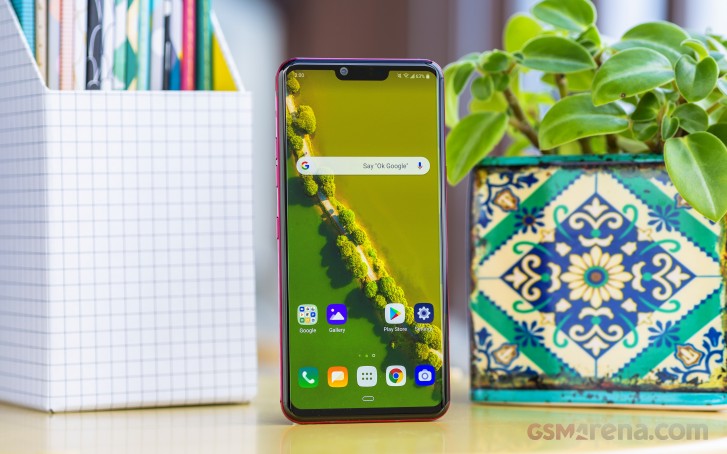 Strangely enough, we think that those features won't be the main
driving factor of a future G8 ThinQ buyer. No, in fact, it's the compact
size of the handset that will attract some customers. Although the 6.1"
screen diagonal isn't exactly "compact", with competing phones easily
touting 6.4-inch or 6.5-inch screen diagonals, this one stands out as a
compact proposition. Price-wise, the G8 ThinQ is also a decent
alternative to the vanilla Samsung Galaxy S10.
Strangely enough, we think that those features won't be the main
driving factor of a future G8 ThinQ buyer. No, in fact, it's the compact
size of the handset that will attract some customers. Although the 6.1"
screen diagonal isn't exactly "compact", with competing phones easily
touting 6.4-inch or 6.5-inch screen diagonals, this one stands out as a
compact proposition. Price-wise, the G8 ThinQ is also a decent
alternative to the vanilla Samsung Galaxy S10.It has to be noted we are reviewing the LG8 model with 2 back-facing cameras. There is a regional model, which also has a 2x telephoto camera but for the time being, it's only available in South Korea.
LG G8 ThinQ specs
- Body: 151.9 x 71.8 x 8.4 mm, 167 grams, metal side frame, Gorilla Glass 5 front and Gorilla Glass 6 on the back; IP68 dust/water proof and MIL-STD-810G compliant.
- Screen: 6.1" OLED, 1440 x 3120px resolution; 19.5:9 aspect ratio; ~564 ppi; 100% DCI-P3, Dolby Vision. HDR10.
- Chipset: Qualcomm SDM855 Snapdragon 855 (7 nm): Octa-core (1x2.84 GHz Kryo 485 & 3x2.42 GHz Kryo 485 & 4x1.79 GHz Kryo 485), Adreno 640 GPU.
- Memory: 6GB RAM, 128GB built-in storage, microSD slot support.
- OS: LG UX based on Android 9.0 Pie.
- Rear camera: Main: 12 MP, f/1.5, 27mm, 1/2.6", 1.4µm, OIS, Dual Pixel PDAF; Ultra-wide: 16 MP, f/1.9, 16mm, 1/3.1", 1.0µm, no AF; LED flash; 1080p@30/60/, 4K@30/60fps, 720p@240fps, HDR10 recording.
- Front camera: 8 MP, f/1.7, 26mm (wide), 1/3.6", 1.22µm, AF; 1080p@30fps video recording + 3D ToF camera.
- Battery: 3,500mAh, Quick Charge 3.0 18W.
- Connectivity: Dual-SIM; LTE-A, 4-Band carrier aggregation, Cat.16/13 (1Gbps/150Mbps); USB-C 3.1; Wi-Fi a/b/g/n/ac; dual-band GPS; Bluetooth 5.0.
- Misc: Piezoelectric screen (Crystal Sound OLED), wireless charging, Hi-Fi Quad DAC via 3.5mm headphone jack, Hand ID, Face Unlock and rear-mounted fingerprint reader.
Unboxing the LG G8 ThinQ
We received the unit in its original packaging containing the usual user manuals, a handy cleaning cloth, and the SIM ejector tool. Surprisingly, there are no earphones included in the package.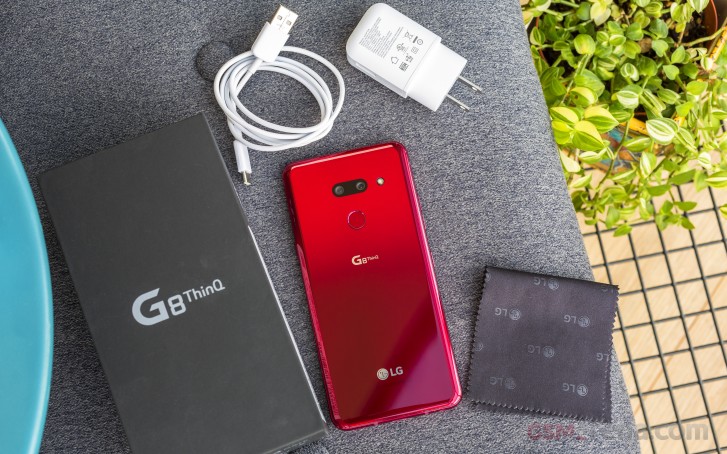 Of course, the charger is in there and it supports 9V/1.8A (16W)
output or in other words Quick Charge 3.0. It comes with a detachable
standard USB-A to USB-C data and charging cable.
Of course, the charger is in there and it supports 9V/1.8A (16W)
output or in other words Quick Charge 3.0. It comes with a detachable
standard USB-A to USB-C data and charging cable.Design, build and 360-degree view
The design hasn't changed much over the last year since the G7 ThinQ, and that's a good thing, to some extent. The device feels solid in hand, despite packing glass panels on both the front and back. The aluminum side frame meets both glass sheets seamlessly.The curved back and the slightly curved front panel make for a comfortable grip. The 6.1-inch screen diagonal suddenly doesn't feel as big and we can even go as far as saying that size-wise, we find it pretty convenient for single-handed use. Reaching the other side of the screen with your thumb is pretty easy.
 While we are on the front, we do have to mention that the bezels
aren't all that impressive. The top and side bezels fall on the thick
side while the chin at the bottom is just a tad smaller than last year's
G7. The curved edges, however, make the side bezels look a lot thinner
than they actually are. The notch is also a little too big for 2019 but
we can let that one slide given that there's some additional 3D-sensing
tech and not just a standard selfie camera.
While we are on the front, we do have to mention that the bezels
aren't all that impressive. The top and side bezels fall on the thick
side while the chin at the bottom is just a tad smaller than last year's
G7. The curved edges, however, make the side bezels look a lot thinner
than they actually are. The notch is also a little too big for 2019 but
we can let that one slide given that there's some additional 3D-sensing
tech and not just a standard selfie camera.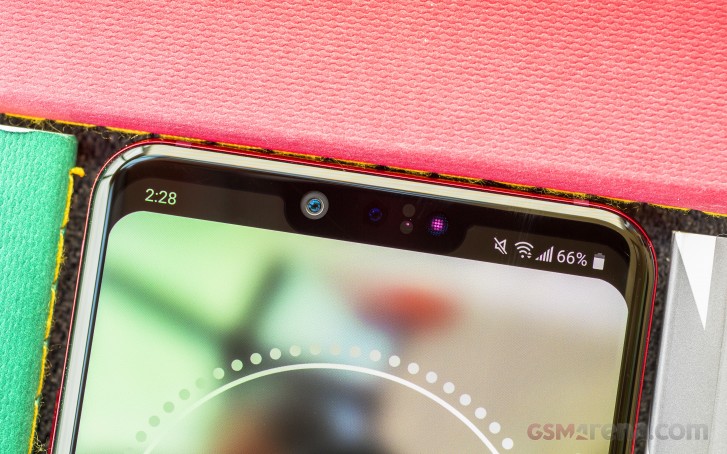 While the rivals have moved over to Gorilla Glass 6 even the models
released in 2018, the G8 ThinQ retains the Gorilla Glass 5 coating on
the front and goes for the GG6 on the back. However, the general user
won't feel much of a difference, and if you drop it, it will break, so
some extra protection for the butterfingers is probably a good idea.
After all, this is a glass sandwich phone and it is slippery.
While the rivals have moved over to Gorilla Glass 6 even the models
released in 2018, the G8 ThinQ retains the Gorilla Glass 5 coating on
the front and goes for the GG6 on the back. However, the general user
won't feel much of a difference, and if you drop it, it will break, so
some extra protection for the butterfingers is probably a good idea.
After all, this is a glass sandwich phone and it is slippery.Traditionally, LG has something the other rivals don't - its G8 complies to the military-grade MIL-STD-810G standard for "Transit Drop' on top of the usual IP68 dust and water resistance.
Our research into this told us that this test was primarily designed for drop testing materiel in certain operational instances such as when transporting the device or when handling it for transportation. It is carried out by dropping it from 4 feet (121cm) onto 5cm-thick plywood over concrete. The device is dropped on each of its six faces, 12 edges, and eight corners, for a total of 26 drops. It's then visually inspected for damage and it's determined whether it still works after each drop.
However, depending on the manufacturer's preference, the 26 drops can be divided among five identical units of a particular device.
So overall, the extent of the increased drop resistance of LG phones is a moot point because compliance is not the same as certification and since there is no independent MIL-STD-810G certification body, we really can't be sure of the exact test parameters for LG phones and the test outcomes just based on the compliance claims alone.
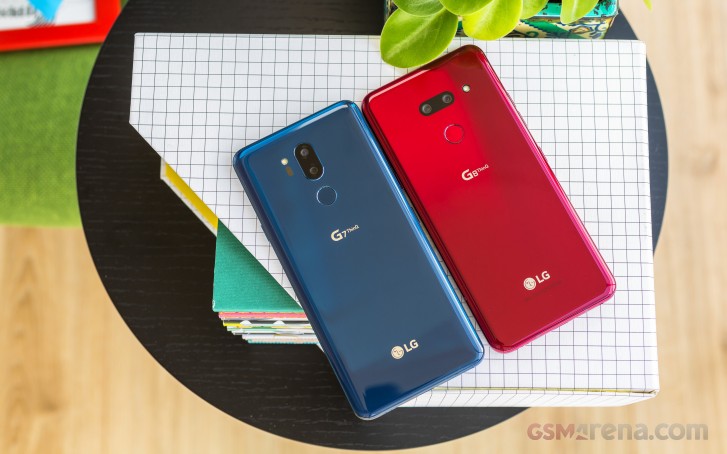 LG G7 and G8 side by side
Durability aside, looks are an important part of the appeal of a
smartphone and our G8 unit arrived in the mesmerizing Carmine Red color,
which is just as stunning as the Moroccan Blue. We can give that to LG -
the gradient colors on the flagship G-series are flashy but elegant at
the same time.
LG G7 and G8 side by side
Durability aside, looks are an important part of the appeal of a
smartphone and our G8 unit arrived in the mesmerizing Carmine Red color,
which is just as stunning as the Moroccan Blue. We can give that to LG -
the gradient colors on the flagship G-series are flashy but elegant at
the same time. LG G7 and G8 side by side
And just like the G7 ThinQ, the G8 also has a slightly curved edges
to the sides that help with the grip and instead of going for the
vertically-stacked camera module, the new flagship adopts the horizontal
alignment. More importantly, though, the camera module now lies flush
with the panel. There's no bump at all, just a small indentation around
the LED flash.
LG G7 and G8 side by side
And just like the G7 ThinQ, the G8 also has a slightly curved edges
to the sides that help with the grip and instead of going for the
vertically-stacked camera module, the new flagship adopts the horizontal
alignment. More importantly, though, the camera module now lies flush
with the panel. There's no bump at all, just a small indentation around
the LED flash. 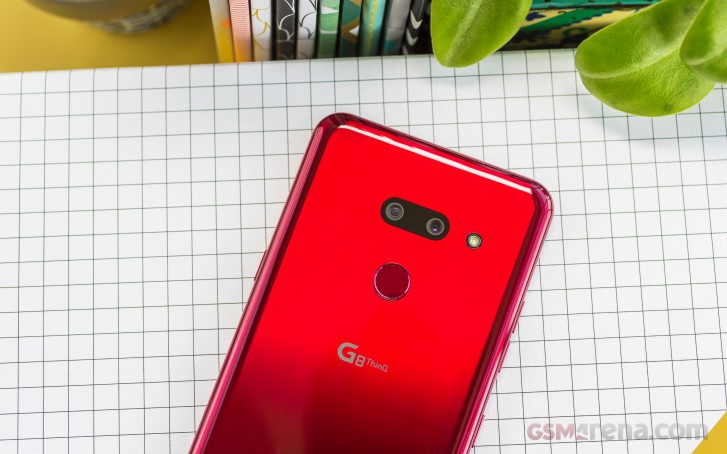 And if you are wondering why LG didn't do it in the first place with
the G7, it's because the G8 is slightly thicker - 8.4 vs 7.9mm. After
all, the G8 houses a bigger battery as well so here's where the extra
girth come from.
And if you are wondering why LG didn't do it in the first place with
the G7, it's because the G8 is slightly thicker - 8.4 vs 7.9mm. After
all, the G8 houses a bigger battery as well so here's where the extra
girth come from.The fingerprint reader is once again placed in the right place - it's easily reachable. It's also pretty responsive, accurate and we didn't find it problematic in any way. The unlock animation is the only thing that slows it down.
The button placement is exactly the same as on the previous generation - there's a power button on the right - a well-placed one - the volume buttons on the left and the dedicated Google Assistant key. There's no wobble to either of the buttons and they are all nice and clicky.
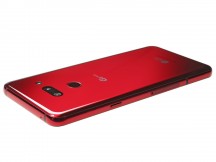
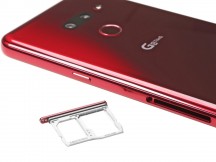

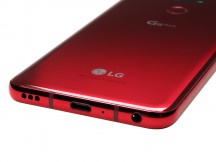

LG G8 ThinQ
Although there's nothing special about the G8 ThinQ's design, it's pretty functional comfortable, and it should be one of the key selling points. It rests well in your hand - it's one of the easiest phones to manage with one hand. We also didn't find any annoying protruding or sharp edges.
Surely, LG could have done a better job with the bezels and the notch but those shouldn't be a deal-breaker in this department anyway.
Here's a good all-around look at the device.




Very Good Post...
ReplyDeleteCrack all Software go to
http://cracka2z.com